

How to Make Hip Hop Grooves in Logic Pro X 10.1 Drum Machine Designer. There’s an art to beat-making that some musicians simply don’t have the patience for.
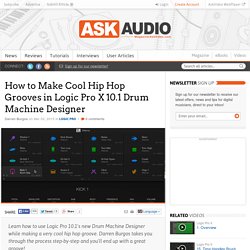
It’s not about instant gratification—like pulling a loop from the loop browser, or even using Logic’s Drummer Track to generate beats with a dozen or so parameters. It’s about making a great sounding groove from scratch that is truly your own creation. Read on for a tour of the new Drum Machine Designer as we create a Hip Hop beat along the way. Creating Deep House Chords in Logic Pro X.
Deep House has really snuck-up on the EDM world in the last few years.
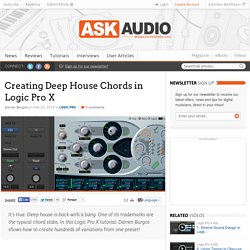
As more and more song producers are requesting deep house remixes of their songs, many remixers are left scratching their heads on ways to approach this genre. In this article we’ll create a quick and simple preset that will give you hundreds of different house/deep house chord stab/bass variations to get you started. In the ’80s and ’90s, sound designers started tuning one or more oscillators on their synthesizers to different musical intervals.
Ever see a patch in one of your synths labeled with a “5th” in its name? This always means that one of the two or more synthesizer oscillators has been transposed seven semitones (a perfect 5th) above the root note. Step 1: Choose Preset and Adjust. How to Record Logic Pro X’s Arpeggiator Notes. It was a long time coming, but it finally happened.
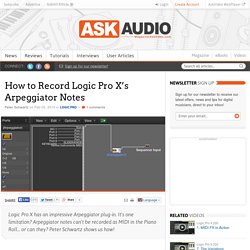
10 Sequencing and Arranging Tips for Logic Pro X. Creating grooves in Logic couldn’t be easier.

Simply looping a 1-, 2-, 4- or 8-bar cycle and perfecting all the elements inside it comes natural to Logic. But when it’s time to sequence/arrange an entire song, things are not quite so straightforward. In this article, I’ll be showing you several tips on expanding your grooves and tracks into fully arranged songs. Separate Each Drum Sound for Sequencing When making drum patterns in Ultrabeat, NI Battery, Microtonic and others, it’s pretty easy to separate each drum sound to new tracks for individual processing.
Use Marquee Tool to Arrange Loops The Marquee tool in Logic is very versatile. How to Record Logic Pro X’s Arpeggiator Notes. 10 Sequencing and Arranging Tips for Logic Pro X. Create Rhythmic Sound Effects using Logic Pro’s Delay Designer : AskAudio Magazine. Delay Designer is Logic’s full featured delay effect.
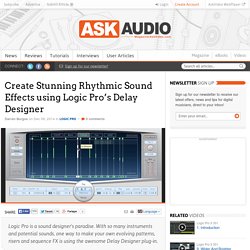
A “delay” literally means what it means; everything that comes out of it, comes out late! In this article, I’ll be showing you its capabilities while designing a few sound FX. With a single one-shot sample or synth tone, we’ll use Delay Designer to create an evolving rhythmic pattern, a riser, and a pitch-based sequence. Music Theory: What is a Secondary Dominant Chord? In this article, I’ll show you how to quickly spice up your chord progressions by adding secondary dominant chords.

Sounds complicated, doesn’t it? It may be at first. But, with a little harmonic theory under your belt, you will find adding one or two secondary dominants an accessible way to add more color, tension and movement to your chord progressions. Secondary dominant chords are not in the tonic key, but work very well as borrowed chords. Creating a Basic Lead Sheet in Logic Pro X. Logic Pro X’s Score Editor is a very deep and powerful tool for creating scores and parts for real players and I literally wrote a Logic Pro 9 book and short Logic Pro X e-book update about it.
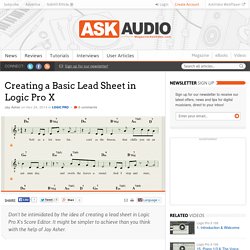
But when all you need to do is create a basic lead sheet, it really is rather simple. In Pic 1, here is the melody to a song I wrote, entitled “Lovely” viewed in the score editor’s default Linear View. Note that you cannot see the whole melody. Pic 1 Entering the Lyrics and the Chords My first task is to enter the lyrics. Pic 2 Pic 3 Now I go to the Part Box in the Inspector and click on the Text icon to select Lyric. Pic 4 In Pic 5, I am dragging the Lyric box to the first note to begin entering the lyrics. Recording Digital Audio and MIDI Masterclass. TILT Show How They Produced new hit, Falling Again, in Logic Pro : AskAudio Magazine. Legendary hit-makers, TILT, propel you deep into the production of their new release “Falling Again.”

Follow along as they deconstruct their creative process in these Logic-based production videos. Nic Britton and Mick Park –the creative force behind TILT– are two of the most innovative producers/DJs in the scene today. In this 20-tutorial course, they take turns explaining their hit-making trade secrets. Watch, hear and learn their innovative electronic music and recording techniques for designing drums, percussion, bass lines, melody and vocals. Then see their cool synth strategies, in-depth breakdown tips and FX techniques that you can replicate in your own electronic dance tracks.
Watch this video on layering basslines from the course: This is followed by a collection of tutorials that peel away the mystical layers of the mix down and mastering prep process.
5 Essential Logic Pro X Piano Roll Tips : AskAudio Magazine. The Piano Roll is used to graphically edit and display any recorded MIDI you’ve played into Logic, or it can be used to step-enter notes directly.

You can also edit the controller data you play like pitch bend and modulation here. In this article I’ll show 5 Piano Roll tips to make working with your MIDI recordings easier. Tip 1 - Make All Notes the Same Length Click a MIDI region in one of your songs and press the P button on the Mac’s keyboard. This opens the Piano Roll window. Tip 2 - Make All Velocities the Same Now while you’re at it, you might also want all MIDI velocities to be the same. Native Instruments Traktor Pro 2 v.2.6.7 - MAC.OSX.rar. How to Hack Logic Pro X’s Drummer to Use with Any Instrument : AskAudio Magazine. By any stretch, the Drummer Instrument in Logic X is an interesting breakthrough in Software Instruments.
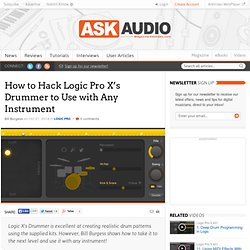
It generates reasonably convincing, albeit quite ordinary drum patterns and fills, synced to your track automatically. Magic! But, for many of us, Drummer is just a bit too close to GarageBand, and just a bit too far from music making. The story ends there. Logic Pro X Tutorial: New Features - Mixing a Song Using 'Track Stacks' w/ Bill Lee. In this Logic Pro X video tutorial, Dubspot Instructor Bill Lee explores Logic’s new Track Stacks function for mixing a song. In this video we will explore the use of Track Stacks in the Logic X mixing workflow. Mixing a song with many instruments can get complicated and sometimes hard to manage. Track Stacks can help simplify the mix process by grouping, submixing and simplifying the visual representation of your musical parts. This is especially useful when you have many tracks of a similar type, like percussion and background vocals.
This is also useful on software instrument tracks as you can see in Matt Shadetek’s latest video tutorial, Using Track Stacks for Big Layered Synths. Logic Pro X - Video Tutorial 01 - Getting Starting in Logic X. LOGIC PRO TUTORIALS. Logic 102: Exploring The EXS24 Video Tutorial - macProVideo.com. Status Available Released Sep 10th, 2009 David Dvorin, the former Manager of Educational Development for Apple's Pro Apps division, shows you how to get the most out of Logic's ESX24 Digital Sampler! The EXS24 is the workhorse sampler that sits at the base of many modern musical compositions. In this tutorial program, David Dvorin demonstrates essential ESX24 sampling skills including how to build your own custom EXS24 instruments. You'll also learn how to accurately trim and loop samples, how to simulate vibrato and use the EXS24's filter section to add realism, and how to import many popular sample libraries including Akai sample CDs and Giga Sampler libraries.
This tutorial provides you with the quick-way into Logic's ESX24 Sampler. For a detailed list of the topics this tutorial covers, check out the Table of Contents. For a full list of the topics covered, see the Tutorial Outline or click the button below to Preview this tutorial. Click the button below to Preview this tutorial. Logic Pro Tutorial: How to Create Multiple Outputs in EXS24 Sampler Instrument w/ Shadetek. How to Create a Custom Instrument with Logic's EXS Sampler. Twice a month we revisit some of our reader favorite posts from throughout the history of Audiotuts+. This tutorial was first published in September 2008. Creating custom sampled instruments using Logic’s EXS24 Software instruments that come jam packed with presets can be bittersweet; there are hundreds of ready-made sounds instantly available at your fingertips, but within months of an instrument’s release the patches become hackneyed and commonplace.
What you may have thought was a unique and exciting instrument can soon become the very sound that makes your music feel just like everything else. How To Load Samples Into Logic's EXS24 Sampler Video by Nzmusic101.